When and how to properly transplant grapes to another place in the fall
Grape bushes are replanted in late autumn or early spring, when they are dormant. Plants transplanted in autumn take root better and wake up earlier in the spring.
You will find detailed information on how to transplant grapes to another place in the fall in this article.
Reasons for moving to a new location
The need for transplantation arises in several cases.
We list the most common reasons:
- the initial location was chosen poorly - the grapes do not have enough sunlight, space for full growth, or they interfere with the growth of neighboring crops;
- the bush does not bear fruit;
- the planting plan on the site has changed;
- the time has come to plant young seedlings growing too close to each other;
- moving the vineyard to another site.
Grapes tolerate transplants well and quickly take root in a new place, so both young plants and adult bushes are replanted.
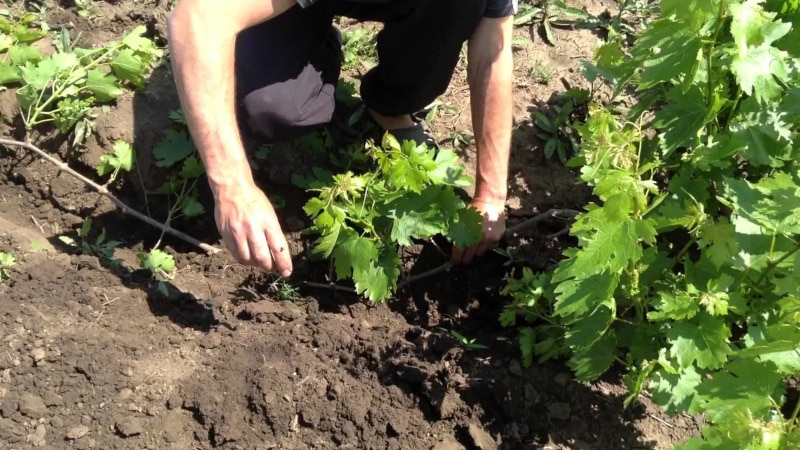
Transplant timing
The plant is replanted after the leaves fall, when it falls asleep for the winter. At this time, the ground has not yet frozen, and the bush will have time to take root before winter arrives. The second option is in the spring, before the buds awaken. When determining the exact timing, they are guided by the weather conditions of the growing region.
Attention! The optimal time for transplantation is autumn (after leaf fall) and spring (before the buds awaken). At this time, the plant is at rest and painlessly survives the transfer to a new location.
It happens that there is a need to replant in the summer, for example, when selling a plot. In this case, the bush is removed along with a large earthen lump and carefully transported.
Advantages of autumn transplantation
There are supporters of both autumn and spring planting. Here are the benefits of planting in the fall:
- Growth processes are suspended, and the soil is still warm enough for rooting, so minimal harm is caused to the plant.
- In autumn there is a larger selection of seedlings, they are of better quality than in spring. Seedlings are harvested at the end of the season and if storage conditions are violated, their quality decreases by spring.
- The soil is moistened by rain in the fall, which reduces the requirements for watering frequency.
- When grown in the south, the soil does not freeze in winter, and the grapes will grow new roots over the winter.
- Grapes planted in autumn wake up earlier in spring.
There is no clear answer to the question of when to replant. The exact date is determined based on climatic conditionsy. The main thing is that the vine has enough time to take root before the soil freezes.
Choosing a new place
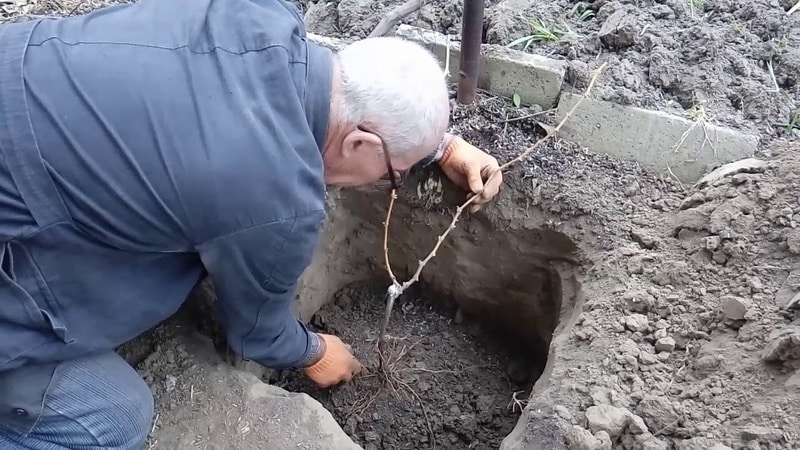
The site for the vines is chosen to be gentle, for example, a southern or southwestern slope. If the site is flat, it should be sunny.
Late varieties are planted near the southern walls of buildings, retreating at least 1 m from them. When placed in several rows, plantings are located from north to south.
Well-groomed grapes decorate the plot. Plantings can be placed along paths, on decorative supports or around a gazebo.
Advice. Do not plant grapes in place of an old bush. The soil there is depleted, and if the bush was sick, the young seedling will also become infected.
When planning a vineyard, they think about how to protect it from cold winds, and make sure that rainwater from the roofs does not flow onto the vines - excess moisture is detrimental to it.
Neighborhood Rules
By choosing the right neighbors for your grapes, you will help them develop healthy.
Favorable
Rose bushes and vines are ideal neighbors. Their pests and diseases are the same, but the rose gets sick first, and the gardener has time to take action and protect the grapes.
Interesting fact! The tradition of planting roses next to grapes came from Europe. Bushes of thorny bushes were planted around vineyards to protect them from horses. The grazing animals, having been pricked by a thorny rose bush, turned back and did not trample the vineyards.
Basil, dill, sorrel, spinach, celandine, and strawberries have a beneficial effect on the vine. Neighborhood with bulbous crops (hyacinths, daffodils, tulips) is acceptable.
Unfavorable
Undesirable neighbors - calendula, parsley, yarrow. These plants oppress young seedlings and slow down their growth. The proximity to perennial colored peas and clary sage is harmful for grapes.
Selection of cuttings
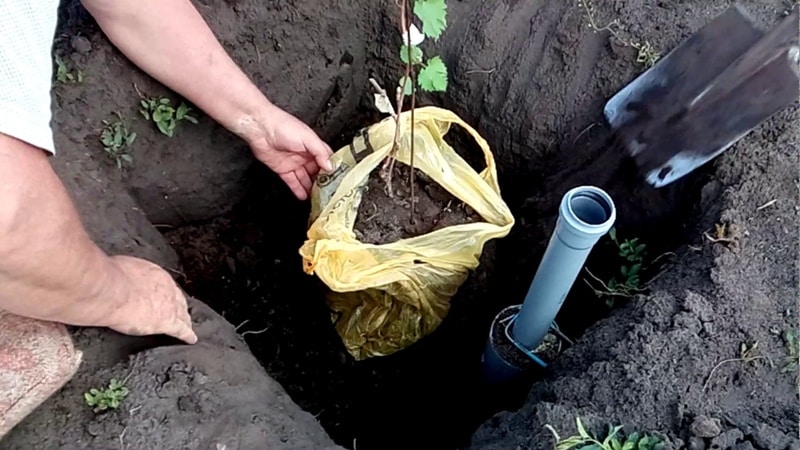
Cuttings are harvested in the fall, during trimmings adult bushes. The middle and lower parts of healthy one-year-old shoots are used. They have matured bark that is dark yellow in color and about 1 cm thick.
Using sharp pruning shears, cut cuttings with 3-4 buds. The lower cut is made under the node, and the upper cut is made in the middle of the internode. The length of each cutting is at least 60 cm. The length reserve will allow you to update the cuts in the spring.
The cuttings are cleared of foliage and shoots and tied into bundles. If there are many cuttings, the harvesting time and grape variety are noted on each bunch.
If planting is planned in the fall, the cuttings are soaked and planted.If in the spring, store planting material in a cool cellar or basement.
Preparation
Let's talk about preparing for transplanting an adult bush, a young plant and a cutting.
Mature bush
Begin preparation by trimming excess vines. Two sleeves with 1-2 year old vines on each are left on the plant. The tops of the vines are cut to 2-3 buds. The sections are treated with RanNet paste or melted garden varnish.
Then the bush is dug around within a radius of 40-50 cm and an earthen ball with roots is removed. Watering before digging is not carried out - this will reduce injury to the roots and simplify the removal of the coma.
Bushes older than 5-7 years are freed from soil, carefully clearing it with a pointed wooden stick. Healthy roots are trimmed, old and diseased ones are completely removed.
Seedlings
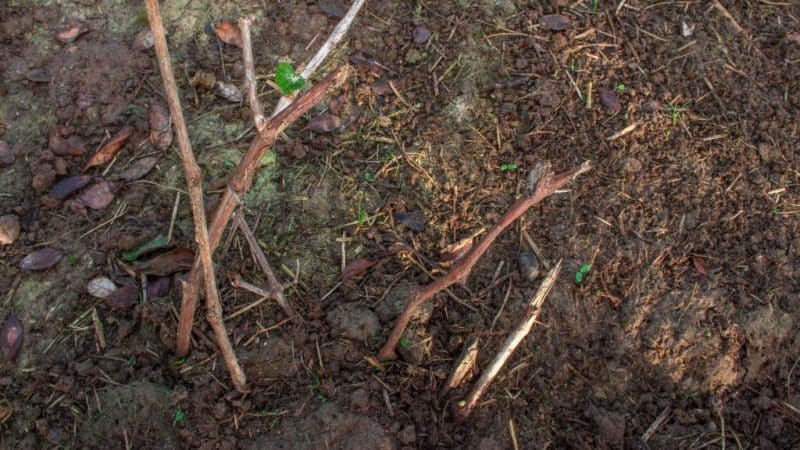
Before planting, young grape bushes are soaked in water for 24 hours. In this case, the entire plant is immersed in water, not just the roots. After the allotted time has passed, the seedlings are removed from the water, the roots are cut to 2-3 cm and planted in the prepared holes.
Cuttings
Cuttings before landing soak in water for 24 hours. Then the lower cut is lowered for a day into a container with a root formation stimulator.
Soil preparation
The pit in the new place is prepared in advance, 2-3 weeks before the intended landing. During this time, the earth in the hole will settle, and the planted plant can be placed at the desired height.
In the selected area, a hole is dug in the shape of a cube with sides of 80 cm. In this case, two separate piles of earth are made. The top layer of soil (about 20 cm) is poured into one, and the rest of the soil into the second.
The top layer is mixed with humus (1:1), 1 kg of ash and 500 g of potassium-phosphorus fertilizers are added. A cushion is made from this mixture at the bottom of a 30 cm high pit and moistened.After settling, the earth is filled up to the previous level and a small mound is made in the center.
A seedling or transplanted bush is placed on this mound and attached to a wooden peg. The roots are covered with the remaining soil from the first pile. The soil from the second heap is mixed with coarse sand and added on top.
Transplant technology
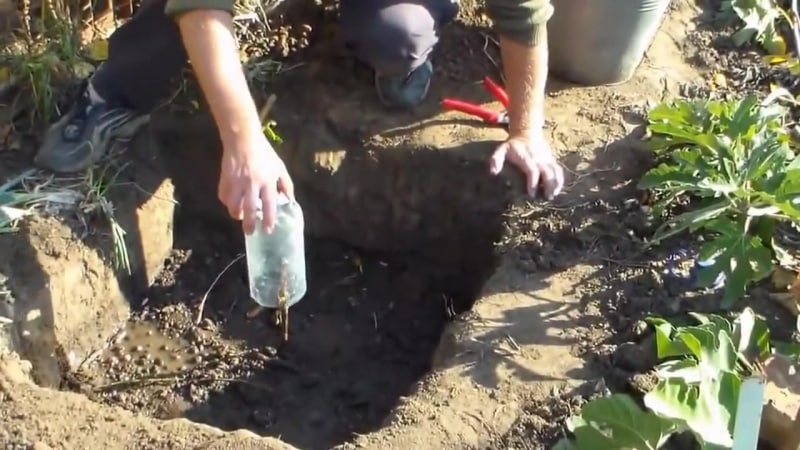
How to replant grapes correctly so that your work is not in vain? First of all, the condition of the bush and its age are assessed. It makes no sense to move sick and old bushes to a new place.
Important! Only young bushes are replanted. Plants older than 7-8 years are not moved to a new place, as there is a high risk that they will not take root or will become sick.
There are several options for replanting grapes: transshipment with an earthen ball, replanting a bush with bare roots and layering.
Together with a lump of earth
The option of transplanting a bush with a lump of earth into a larger hole is called transshipment. It is preferable for young bushes 1-3 years old. To prevent the lump of earth with roots from falling apart, the plants are not watered for 1-2 days before transplantation and the roots are not shortened.
At the site of the uprooted bush, the soil should rest for at least two years; replanting grapes there is not recommended. If you have to do this, you need to replace the soil in the old hole and plant a young bush in the center of it.
Bare root
This method is used for bushes older than three years. Their overgrown root system is difficult to remove along with a lump of earth and move to a new location.
The transplant procedure is as follows.
- First, the vines are trimmed, leaving two sleeves with two shoots on each. 3-4 buds are left on each shoot.
- The bush is dug in, the roots going deep are trimmed.
- The soil is removed from the roots and the ends of the roots are trimmed.
After this, the grapes are ready to be planted in a new hole. If everything is done correctly, the grapes will recover in the next season and begin to bear fruit within a year.
Layering
If an old grape bush is moved not far from its original location, it is not necessary to completely dig it up - it is better to grow cuttings. This is a vegetative method of propagation, when the shoots are rooted, buried in the ground, but not separated from the mother bush. The shoots on the cuttings are nourished not only by their own roots, but also by the mother plant.
If the bush does not have a vine long enough to bring its end to the desired place, the layering is repeated or the vine is lengthened by grafting a cutting of the required length. And vice versa, if necessary, reduce the length of the layering, bending the vine around the trunk.
Transplantation by layering is used to fill empty space or replace a dead plant.. The main advantages of this method are simplicity and the bush begins to bear fruit the very next year.
After two years, the cuttings are separated from the mother plant. If desired, you can not separate them and, over time, get a whole row of bushes with a central root system.
Care after transplant
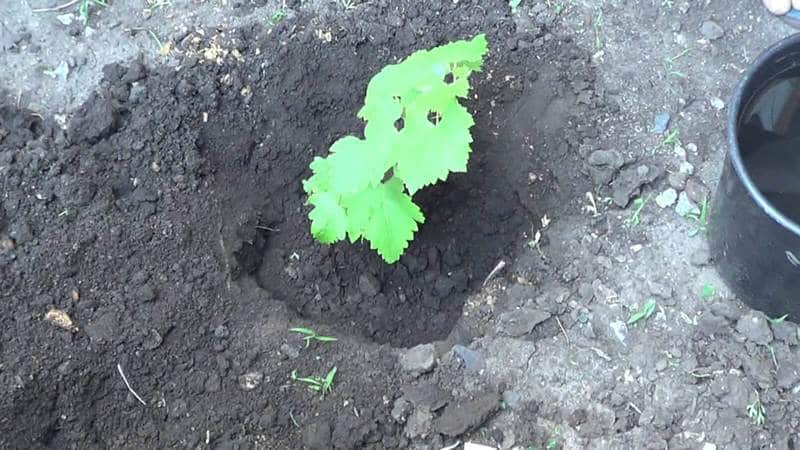
The first thing to do after transplanting is to moisten the soil. The plant needs water for rapid rooting and successful wintering.
Need to know! Wet soil freezes less during frosts. Abundant watering of grape bushes before sheltering for the winter will prevent freezing of the root system.
A vine saturated with moisture will wake up earlier in the spring and begin to grow. Watering is stopped after covering the bushes for the winter.
When watering, take into account the soil composition. If the soil is sandy, about 50-60 liters of water will be required for each adult bush.If it is black soil or loam - 25-30 liters. For seedlings, the norm is halved.
To protect against diseases and pests, transplanted plants are sprayed with a 1% solution of Bordeaux mixture.
IN feeding grapes transplanted in autumn do not need – fertilizers have already been applied when preparing the planting hole.
The final stage of autumn care for transplanted plants is shelter for the winter.
Attention! The grapes are covered when the daytime temperature remains stably below zero (from 0 to -3°C).
When grown in the Krasnodar Territory (Kuban), cover grapes for the winter not necessary. But, for example, in the Rostov, Astrakhan or Volgograd regions you cannot do without this procedure. Despite the fact that the average winter temperature in these regions does not fall below -15°C, sudden temperature changes and thaws are not uncommon here. A slight frost after a thaw is enough to destroy all the buds.
The nuances of transplantation depending on the growing region
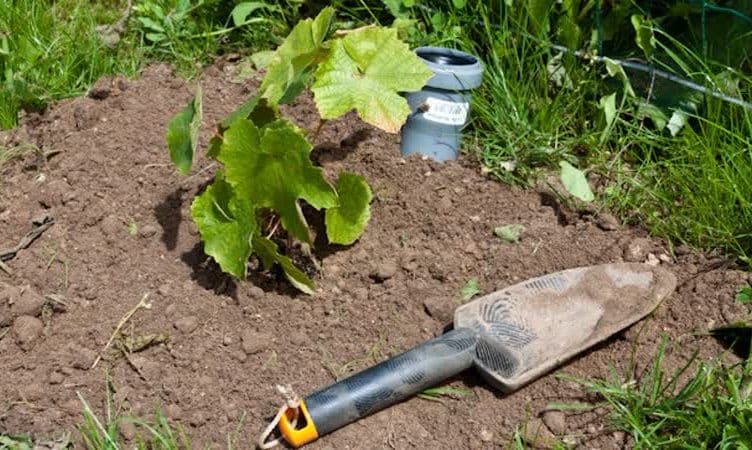
When determining the timing of replanting a grape bush, the climatic features of the region where the crop is cultivated are taken into account.
In the southern regions, early warming in the spring is often replaced by a sharp cooling. Therefore, it is difficult to choose the right time for transplantation. In such conditions, it is preferable to replant in the fall.
When planting in autumn, it is important to choose the right moment. Vine growth slows down when the soil temperature drops to +8°C. But this temperature is enough for the seedling to take root before the cold weather arrives.
Conclusion
Caring for grapes is not the easiest task. From time to time the vines have to be replanted. Think in advance where and how you will move the plant, prepare the place.Properly carried out autumn replanting will allow the grapes to quickly take root and begin to bear fruit earlier.